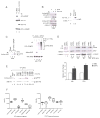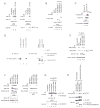Loss of JAK2 regulation via a heterodimeric VHL-SOCS1 E3 ubiquitin ligase underlies Chuvash polycythemia
- PMID: 21685897
- PMCID: PMC3221316
- DOI: 10.1038/nm.2370
Loss of JAK2 regulation via a heterodimeric VHL-SOCS1 E3 ubiquitin ligase underlies Chuvash polycythemia
Abstract
Chuvash polycythemia is a rare congenital form of polycythemia caused by homozygous R200W and H191D mutations in the VHL (von Hippel-Lindau) gene, whose gene product is the principal negative regulator of hypoxia-inducible factor. However, the molecular mechanisms underlying some of the hallmark abnormalities of Chuvash polycythemia, such as hypersensitivity to erythropoietin, are unclear. Here we show that VHL directly binds suppressor of cytokine signaling 1 (SOCS1) to form a heterodimeric E3 ligase that targets phosphorylated JAK2 (pJAK2) for ubiquitin-mediated destruction. In contrast, Chuvash polycythemia-associated VHL mutants have altered affinity for SOCS1 and do not engage with and degrade pJAK2. Systemic administration of a highly selective JAK2 inhibitor, TG101209, reversed the disease phenotype in Vhl(R200W/R200W) knock-in mice, an experimental model that recapitulates human Chuvash polycythemia. These results show that VHL is a SOCS1-cooperative negative regulator of JAK2 and provide biochemical and preclinical support for JAK2-targeted therapy in individuals with Chuvash polycythemia.
Conflict of interest statement
The authors declare no competing financial interests.
Figures






Similar articles
-
Systemic VHL gene functions and the VHL disease.FEBS Lett. 2012 Jun 4;586(11):1562-9. doi: 10.1016/j.febslet.2012.04.032. Epub 2012 Apr 25. FEBS Lett. 2012. PMID: 22673568 Free PMC article. Review.
-
The Role of VHL in the Development of von Hippel-Lindau Disease and Erythrocytosis.Genes (Basel). 2022 Feb 17;13(2):362. doi: 10.3390/genes13020362. Genes (Basel). 2022. PMID: 35205407 Free PMC article. Review.
-
The phenotype of polycythemia due to Croatian homozygous VHL (571C>G:H191D) mutation is different from that of Chuvash polycythemia (VHL 598C>T:R200W).Haematologica. 2013 Apr;98(4):560-7. doi: 10.3324/haematol.2012.070508. Epub 2013 Feb 12. Haematologica. 2013. PMID: 23403324 Free PMC article.
-
The homozygous VHL(D126N) missense mutation is associated with dramatically elevated erythropoietin levels, consequent polycythemia, and early onset severe pulmonary hypertension.Pediatr Blood Cancer. 2014 Nov;61(11):2104-6. doi: 10.1002/pbc.25056. Epub 2014 Apr 12. Pediatr Blood Cancer. 2014. PMID: 24729484
-
von Hippel-Lindau mutation in mice recapitulates Chuvash polycythemia via hypoxia-inducible factor-2alpha signaling and splenic erythropoiesis.J Clin Invest. 2007 Dec;117(12):3879-89. doi: 10.1172/JCI32614. J Clin Invest. 2007. PMID: 17992257 Free PMC article.
Cited by
-
Novel compound VHL heterozygosity (VHL T124A/L188V) associated with congenital polycythaemia.Br J Haematol. 2013 Sep;162(6):851-3. doi: 10.1111/bjh.12431. Epub 2013 Jun 17. Br J Haematol. 2013. PMID: 23772956 Free PMC article. No abstract available.
-
Systemic VHL gene functions and the VHL disease.FEBS Lett. 2012 Jun 4;586(11):1562-9. doi: 10.1016/j.febslet.2012.04.032. Epub 2012 Apr 25. FEBS Lett. 2012. PMID: 22673568 Free PMC article. Review.
-
The Role of VHL in the Development of von Hippel-Lindau Disease and Erythrocytosis.Genes (Basel). 2022 Feb 17;13(2):362. doi: 10.3390/genes13020362. Genes (Basel). 2022. PMID: 35205407 Free PMC article. Review.
-
Activation of γ-globin expression by hypoxia-inducible factor 1α.Nature. 2022 Oct;610(7933):783-790. doi: 10.1038/s41586-022-05312-w. Epub 2022 Oct 12. Nature. 2022. PMID: 36224385 Free PMC article.
-
Investigation and Management of Erythrocytosis.Curr Hematol Malig Rep. 2016 Oct;11(5):342-7. doi: 10.1007/s11899-016-0334-1. Curr Hematol Malig Rep. 2016. PMID: 27423232 Review.
References
-
- Ivan M, et al. HIFalpha targeted for VHL-mediated destruction by proline hydroxylation: implications for O2 sensing. Science. 2001;292:464–8. - PubMed
-
- Jaakkola P, et al. Targeting of HIF-alpha to the von Hippel-Lindau ubiquitylation complex by O2- regulated prolyl hydroxylation. Science. 2001;292:468–72. - PubMed
-
- Maxwell P, et al. The von Hippel-Lindau gene product is necessary for oxgyen-dependent proteolysis of hypoxia-inducible factor α subunits. Nature. 1999;399:271–5. - PubMed
-
- Ohh M, et al. Ubiquitination of hypoxia-inducible factor requires direct binding to the beta-domain of the von Hippel-Lindau protein. Nat Cell Biol. 2000;2:423–7. - PubMed
-
- Roberts AM, Ohh M. Beyond the hypoxia-inducible factor-centric tumour suppressor model of von Hippel-Lindau. Curr Opin Oncol. 2008;20:83–9. - PubMed
Publication types
MeSH terms
Substances
Grants and funding
LinkOut - more resources
Full Text Sources
Other Literature Sources
Molecular Biology Databases
Miscellaneous

